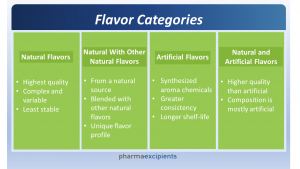What are Flavors?
Flavor Categories
By regulation, flavors are categorized by the Code of Federal Regulations (21CFR101.22) into four types depending on their composition:
- Natural Flavors
- Natural With Other Natural Flavors (WONF)
- Artificial Flavors
- Natural and Artificial (N&A) Flavors

As a formulator, you need to consider the utility and different performance characteristics of each flavor type. We’ll break them down here.
Natural Flavors
FDA defines a natural flavor as “the essential oil, oleoresin, essence or extractive, protein hydrolysate, distillate, or any product of roasting, heating or enzymolysis, which contains the flavoring constituents derived from a spice, fruit or fruit juice, vegetable or vegetable juice, edible yeast, herb, bark, bud, root, leaf or similar plant material, meat, seafood, poultry, eggs, dairy products, or fermentation products thereof, whose significant function in food is flavoring rather than nutritional.” Interestingly, this is the only time the FDA formally defines the term “natural”; much to the frustration of many in the food industry.
In a natural flavor, the aroma chemicals must be extracted from the source substance (e.g. a natural strawberry must come from a strawberry plant – berry, leaf or stem). The methods of extraction can involve extrusion, solvent extraction, or distillation.
Natural flavors are typically the highest quality (and cost), but as they are derived from natural sources, their composition tends to be both complex and variable. They are also the least stable and are generally not used in drug products.
Natural With Other Natural Flavors
Similar to natural flavors, Natural With Other Natural Flavors (WONF) come from a natural source, but may be blended with other natural flavors (a natural strawberry WONF may contain natural peach flavors, for example). WONF’s can be less prone to variation in flavor characteristics. Due to these blends, they may also have a more unique flavor profile and can be cheaper to produce than their natural counterparts. Natural WONF are generally not used in drug products.
Artificial Flavors
Formally, the FDA classifies artificial flavors by exception, and “any substance, the function of which is to impart flavor” that is not a natural flavor, is an artificial flavor.
In practicality, artificial flavors are mixtures of individual synthesized aroma chemicals, which may be nature-identical. These are combined together in ratios that emulate a natural aroma. Because of increased purity and compositional uniformity, artificial flavors benefit from greater consistency (less batch to batch variation) and decreased impact from raw material changes. Because artificial flavors are assembled from individual chemicals, more reactive species can be omitted from the blend. Thus, they tend to withstand greater thermal stress during processing and have a longer shelf-life than their natural counterparts. For these reasons, artificial flavors are commonly used in drug products.
Natural and Artificial Flavors
As the name implies, Natural and Artificial Flavors (N&A) combine natural flavors with artificial flavors, without regard to the mass fraction of either constituent. It is common knowledge in the industry that the composition of N&A flavors is mostly artificial. N&A flavors are generally higher in flavor quality than artificial – though somewhat more variable. They are less expensive than WONF and are commonly used in drug products.
The Role of Flavors in Palatable Drug Products
Flavors generally play a minor role in taste masking, particularly when the challenge is bitterness or trigeminal irritation owing to differences in the physiology of taste, smell and chemesthesis. However, they are useful in masking a malodor from the API (e.g. the sulfurous aromatic of some antibiotics) or excipient (e.g., oxidized oil aromatics of most emulsifiers).
Illustrative Blog Post for pharmaexcipients.com – Prepared by Senopsys LLC by David Tisi — All Rights Reserved
David Tisi is the Technical Director of Senopsys LLC, a specialty services firm dedicated to the development of palatable drug products. He has 15 years of experience in taste assessment and taste masking of investigational and approved drugs for children and adults, leveraging his background in sensory science and food chemistry. He can be reached at [email protected]


